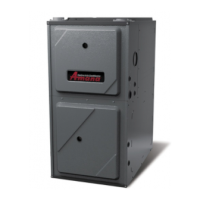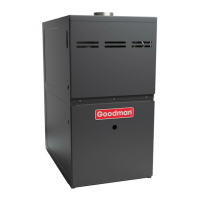SYSTEM OPERATION
26
The normal operational sequence in cooling mode is as
follows:
1. R and Y thermostat contacts close, initiating a call for cool.
2. Integrated control module performs safety circuit checks.
3. Outdoor fan and compressor are energized.
4. Circulator blower is energized on cool speed following a
xed seven (7) second on delay.
5. Furnace circulator blower and outdoor cooling unit
run, integrated control module monitors safety circuits
continuously.
6. R and Y thermostat contacts open, completing the call for
cool.
7. Outdoor fan and compressor are de-energized.
8. Circulator blower is de-energized following a xed sixty
ve (65) second cool o delay period.
9. Furnace awaits next call from thermostat.
The normal operational sequence in fan only mode is as
follows:
1. R and G thermostat contacts close, initiating a call for fan.
2. Integrated control module performs safety circuit checks.
3. Circulator blower is energized on . Electronic
air cleaner terminals are energized.
4. Circulator blower runs, integrated control module monitors
safety circuits continuously.
5. R and G thermostat contacts open, completing the call
for fan.
6. Furnace awaits next call from thermostat
7. Furnace awaits next call from thermostat.
The following presents the probable causes of questionable
furnace operation and how to x them. Look through the
observation window in the blower access door and make a
note of the number of ashes in sequence between pauses.
Next, refer to the Troubleshooting Chart on the following
pages for an interpretation of the LED signals and to the
information in this section for a description of the problem.
1.
Check for voltage to the furnace and low voltage
at the control board. Check for blown fuse on the control
board. If the control determines it has an internal fault, it
enters a locked-out state. Any of the situations mentioned
will cause the diagnostic LED to provide The
control board should only be replaced after all other
checks from the Troubleshooting Chart have been veried.
2. If a ame is not sensed during the rst
seven (4) seconds after the gas valve is energized, the
control turns o the gas. There will then be a 30 second
delay while the induced draft blower is energized to purge
the heat exchanger. The ignitor will next be energized and
preheated. The gas valve will then be energized. If ame
is not sensed in seven (4) seconds the gas valve will be
de-energized and another purge will occur. The control
will cycle the gas valve a total of three (3) times before
it determines it cannot establish measurable combustion
and enters a locked out state. The diagnostic light code
for this problem is followed by a longer
pause. The control can be reset and brought out of lockout
mode by turning the thermostat o for more than (5)
seconds and less than (20) seconds and then back on. It
can also be reset by turning o the electrical disconnect
switch to the furnace for a minimum of 5 seconds.
The control board will automatically reset one hour
after lockout occurs. If the furnace frequently has to be reset,
it means that a problem exists that should be corrected. Refer
to Troubleshooting Chart on the following pages for aid in
determining the cause.
3. If the control senses the
pressure switch is closed when the induced draft blower is
o, it waits until the fault is corrected. The diagnostic light
code for this problem is 2 . The probable cause is
either a faulty pressure switch or wiring.
4. If, after the induced draft
blower is energized, the pressure switch does not close
within 5 minutes, the control will go into a 1-hour lockout.
The control will automatically reset from lockout and restart
the ignition sequence. The diagnostic light code for this
problem is followed by a pause.
The probable causes are either disconnected hose to
the pressure switch, faulty pressure switch or wiring, or
restricted air intake or ue piping.
5. If the limit control
opens, the air circulator blower will be turned on until the
limit closes. The induced draft blower will turn o for 5
seconds then turn o. The diagnostic light code for this
problem is followed by a pause. The
probable cause is either low conditioned air ow due to
dirty lter or resistance in duct work, faulty limit, faulty
blower, or blower speed set to low.
6. If the control
senses a ame when the gas valve is de-energized, it
will run the air circulation blower and the induced draft
blower continuously with no further furnace operation.
The diagnostic ash code for this is a
7. If the
rollout control opens, the air circulator blower will be
energized all the time. The diagnostic light code for this
problem is followed by a pause. The probable
cause is either restricted flue piping or improper air
requirements.

